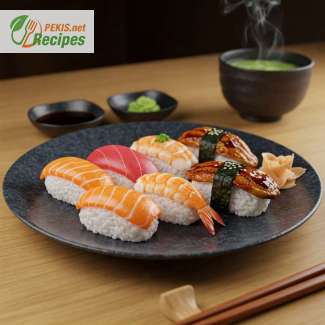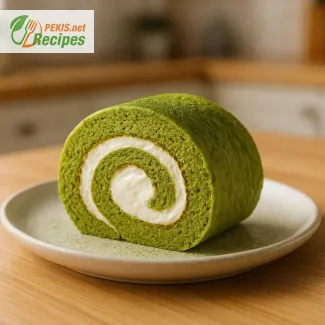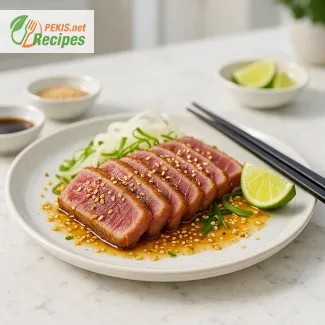
The Art of Crafting Perfect Nigiri Sushi
A Delicate Balance of Simplicity and Elegance
Nigiri sushi is one of the most iconic and refined forms of Japanese cuisine. Unlike elaborate sushi rolls, nigiri is all about the purest expression of fresh seafood, served on a perfectly shaped bed of seasoned sushi rice. This sushi variety celebrates balance, precision, and texture, making it a favorite among sushi enthusiasts worldwide.
Originating from Edo-period Japan, nigiri sushi has remained a staple in traditional sushi bars and omakase restaurants, where chefs meticulously prepare each piece with expert craftsmanship. While it may seem like an art reserved for master sushi chefs, you can achieve restaurant-quality nigiri in your own kitchen with the right techniques, ingredients, and attention to detail.
The Essence of Nigiri: Quality Ingredients Matter
At the heart of every great nigiri sushi is two essential elements: high-quality fish and perfectly seasoned rice. Since nigiri showcases the natural flavors of seafood, selecting the freshest fish is paramount. Traditional options include tuna (maguro), salmon (sake), yellowtail (hamachi), shrimp (ebi), and eel (unagi).
Equally important is sushi rice (shari)—its texture, temperature, and seasoning define the final taste of the dish. Short-grain Japanese rice, properly rinsed, cooked, and seasoned with a delicate blend of rice vinegar, sugar, and salt, provides the ideal foundation for nigiri. The rice must be sticky yet light, holding its shape without overpowering the fish.
Mastering the Technique: A Test of Precision
The beauty of nigiri sushi lies in its simplicity, but don’t be fooled—perfecting it requires patience and practice. Each piece is crafted by gently shaping a small mound of sushi rice and delicately layering a slice of fish on top. The pressure applied must be just right—firm enough to hold together yet soft enough to melt in the mouth.
Sushi chefs train for years to master this skill, but with a few practice rounds, you’ll be shaping authentic, well-balanced nigiri in no time. A key tip is to use slightly wet hands to prevent the rice from sticking while maintaining a delicate touch.
Elevating Nigiri: The Final Touches
While traditional nigiri sushi is often served with a touch of wasabi between the rice and fish, modern variations introduce subtle enhancements. A light brush of soy sauce (shoyu), a hint of yuzu citrus, or a sprinkle of sesame seeds can accentuate the flavors. Some chefs lightly sear the fish (aburi-style) using a torch, creating a smoky depth to the dish.
Pairing nigiri with pickled ginger (gari) and high-quality soy sauce further enhances the tasting experience. Remember, when dipping nigiri in soy sauce, turn it fish-side down to avoid oversaturating the rice, which could affect the delicate texture.
Why Homemade Nigiri is Worth the Effort
While sushi restaurants provide a spectacular experience, making nigiri sushi at home offers an entirely new level of appreciation for the craft of Japanese cuisine. By selecting premium ingredients, controlling every step of the process, and tailoring the flavors to your preference, you can create a personalized sushi experience that rivals top-tier sushi bars.
Whether you’re hosting a sushi night with friends, impressing guests at a dinner party, or simply indulging in a gourmet homemade meal, mastering the art of nigiri sushi is a skill that brings both culinary satisfaction and cultural connection. With practice, each carefully shaped piece becomes a testament to tradition, precision, and the joy of simple yet exquisite flavors.
- Prepare the sushi rice:
- Rinse the short-grain rice under cold water until the water runs clear.
- Cook the rice using a rice cooker or in a pot with 360 ml (1 ½ cups) of water. If using a pot, bring to a boil, then cover and simmer for 15 minutes. Let it rest for 10 minutes.
- In a small saucepan, heat the rice vinegar, sugar, and salt over low heat until dissolved. Do not boil.
- Gently fold the vinegar mixture into the rice using a wooden spoon, being careful not to mash the grains. Let it cool to room temperature.
- Prepare the fish:
- Slice the salmon, tuna, shrimp, or eel into thin, even pieces approximately 5 cm (2 inches) long and 3 cm (1.2 inches) wide.
- If using shrimp, boil them briefly and butterfly them open.
- Shape the nigiri:
- Wet your hands with water and a little vinegar to prevent the rice from sticking.
- Take a small portion of sushi rice (about 20 g or 1 tbsp) and gently shape it into an oval.
- Apply a tiny dab of wasabi to one side of the sliced fish.
- Place the fish on top of the rice and press lightly with your fingers to secure it.
- Serve:
- Arrange the nigiri sushi on a plate and serve with soy sauce, pickled ginger, and additional wasabi on the side.
Elevating Nigiri Sushi: Techniques and Ingredients for a Superior Experience
Small Changes, Big Impact
Nigiri sushi may seem simple at first glance, but the mastery behind this dish is in the fine details. Every component—from the rice texture to the fish’s thickness—plays a crucial role in achieving an exceptional bite. While traditional recipes follow time-honored techniques, subtle refinements can take homemade nigiri to the next level. Whether it’s through ingredient selection, advanced preparation methods, or small but effective modifications, the following insights will help you transform ordinary nigiri into a gourmet experience.
Perfecting the Sushi Rice for Optimal Texture
Sushi rice, or shari, is the foundation of nigiri and can make or break the dish. While a traditional approach ensures consistency, a few adjustments can significantly enhance the final result:
Choosing the Right Rice
- Always opt for premium short-grain sushi rice from Japan, such as Koshihikari or Sasanishiki, which have the perfect balance of stickiness and individual grain structure.
- Rinse the rice at least three times before cooking to remove excess starch, ensuring a light yet cohesive texture.
Balancing Vinegar Seasoning
- Experiment with different vinegar blends—while rice vinegar is standard, mixing in a touch of apple cider vinegar or yuzu vinegar can add a subtle fruitiness that enhances the sushi’s freshness.
- Adjust the sugar-to-vinegar ratio based on the type of fish you’re using—sweeter rice complements stronger-flavored fish like mackerel, whereas a more acidic balance pairs well with delicate cuts like flounder or sea bream.
Temperature Matters
- One of the most common mistakes in homemade nigiri is serving the rice too cold or too hot. The ideal temperature is body temperature (around 37°C or 98°F)—this allows the rice to meld seamlessly with the fish for a smooth, melt-in-your-mouth experience.
Enhancing the Flavor Profile of the Fish
While high-quality fish is non-negotiable, there are ways to further intensify its natural umami and texture.
Aging the Fish for Depth of Flavor
- Sushi chefs often age their fish for a few days to enhance umami. Tuna, for example, develops a richer, deeper flavor when wrapped in kombu (kelp) and stored for 24 to 48 hours before slicing.
- White fish such as flounder benefits from light curing in salt for 30 minutes, followed by a rinse in sake to remove excess moisture and concentrate its flavors.
Lightly Seared Variations (Aburi-Style)
- For a unique twist, consider using a kitchen torch to lightly sear the surface of fatty fish like salmon or toro (fatty tuna). The heat caramelizes natural fats, intensifying the flavor and adding a slightly smoky aroma.
- Brushing the seared fish with a touch of soy sauce or yuzu ponzu before serving enhances the umami profile.
Marination and Seasoning
- Instead of serving fish raw, try marinating certain cuts for added complexity. Tuna soaked in soy sauce and mirin for 10 minutes develops an elegant depth, while salmon cured with a sprinkle of salt and citrus zest gains a brighter, more refined taste.
- A tiny brush of nikiri (sweet soy glaze) on lean fish can enhance richness without overpowering the natural flavors.
Common Mistakes to Avoid
Even with great ingredients, small missteps can compromise the balance and presentation of nigiri.
- Overpacking the rice: Sushi rice should be gently formed, never squeezed. Too much pressure results in a dense, chewy texture instead of a delicate bite.
- Improper fish slicing: Always cut against the grain for a tender texture. Too thick, and the fish will overpower the rice; too thin, and it may not hold its shape properly.
- Excessive wasabi: A light dab of wasabi is enough—too much can overwhelm the delicate flavors of the fish.
Healthier and Alternative Nigiri Variations
For those looking to reduce calories, increase nutrients, or explore plant-based options, there are several innovative approaches to nigiri.
Whole-Grain Sushi Rice
- Replacing white sushi rice with brown sushi rice or a blend of quinoa and short-grain rice increases fiber and minerals while maintaining a slightly nutty yet sticky texture.
- If you prefer a lower-carb alternative, using cauliflower rice lightly seasoned with vinegar mimics the tangy profile of sushi rice with fewer carbohydrates.
Plant-Based and Sustainable Alternatives
- Avocado slices can replace raw fish, offering a creamy, umami-rich bite.
- Marinated king oyster mushrooms have a silky texture similar to scallops when sliced thinly and brushed with soy sauce.
- Carrot lox (thinly shaved, smoked, and marinated carrots) is a great substitute for salmon nigiri, providing a similar smoky depth.
- Jackfruit or young coconut flesh can mimic the texture of tuna when properly seasoned with soy sauce and kombu extract.
The Superiority of Homemade Nigiri
While sushi restaurants offer high-quality nigiri, making it at home allows for greater control over ingredients, freshness, and creativity.
- Cost efficiency: High-end sushi restaurants charge a premium for nigiri. Making it at home allows you to enjoy gourmet-quality sushi at a fraction of the price.
- Ingredient transparency: You control the sourcing of fish, ensuring it is sustainably harvested and free from artificial preservatives.
- Personalization: Customize rice seasoning, fish selection, and garnishes to your exact preference, experimenting with different textures and flavors.
Improving traditional nigiri sushi comes down to thoughtful ingredient selection, precise technique, and creative enhancements. Whether refining the balance of sushi rice, aging the fish, or experimenting with new textures and flavors, small adjustments can yield remarkable improvements. By avoiding common pitfalls and embracing alternative ingredients, homemade nigiri can rival even the best sushi bars, offering a truly personalized and rewarding culinary experience.
- Contains: Fish, soy (if using soy sauce)
- Gluten: Traditional soy sauce contains gluten. Use gluten-free soy sauce to make this recipe safe for gluten-sensitive individuals.
Ingredient Substitutions for Allergies & Gluten-Free Variations:
- Fish allergy: Replace raw fish with thinly sliced avocado, tamago (Japanese omelet), or cooked mushrooms.
- Gluten-free: Use tamari soy sauce instead of regular soy sauce.
- Vitamin B12: Supports red blood cell formation and nervous system function.
- Omega-3 fatty acids: Found in salmon and tuna, beneficial for heart and brain health.
- Iron: Essential for oxygen transport in the blood.
- Selenium: Supports immune function and thyroid health.
- Astaxanthin (from salmon): Reduces inflammation and promotes skin health.
- Vitamin E (from fish and rice): Protects cells from oxidative damage.
- Polyphenols (from rice vinegar): Supports digestion and metabolism.





